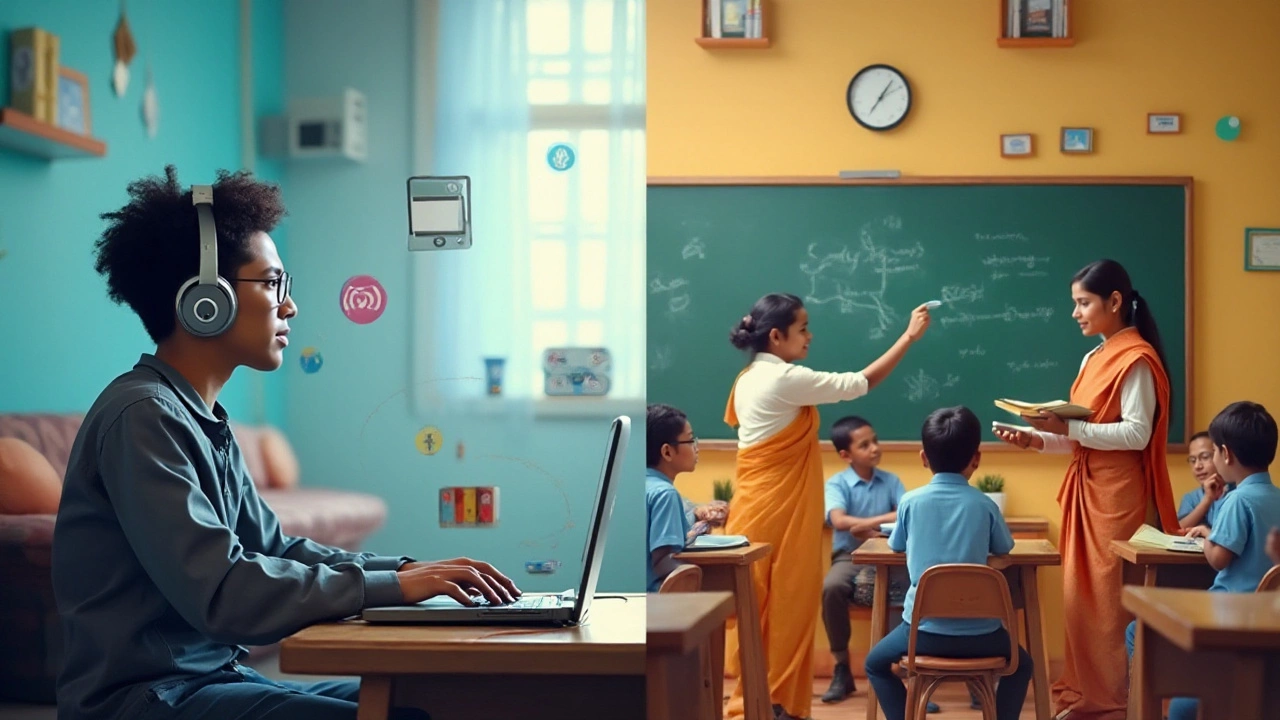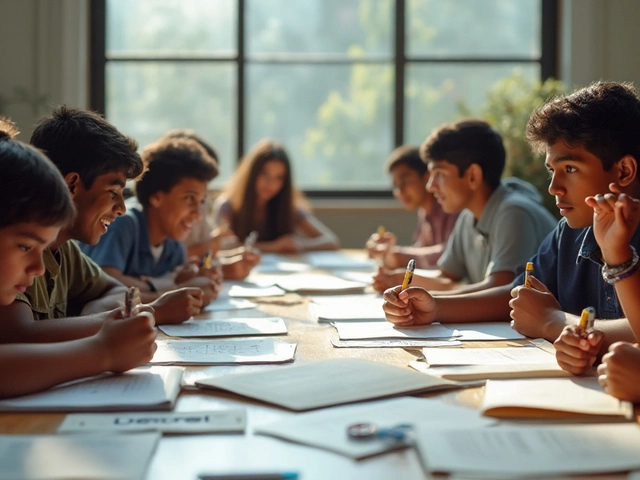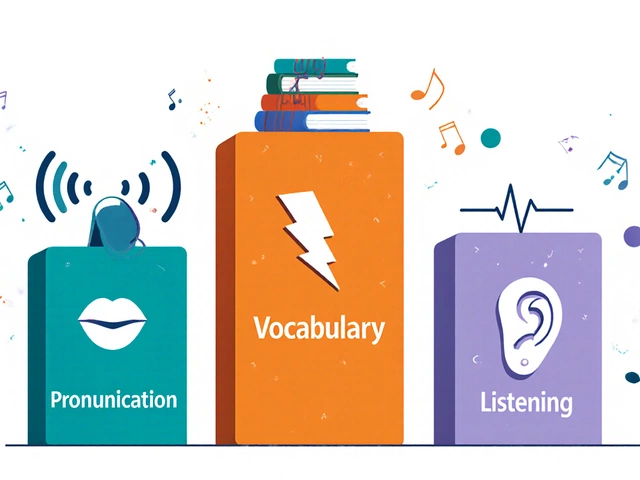Jan
3

- by Dhruv Ainsley
- 0 Comments
In recent years, the education landscape has dramatically transformed, presenting learners with several options for acquiring knowledge. Two primary methods stand out: eLearning and classroom learning. Each approach offers unique advantages and potential drawbacks, making it crucial for individuals to understand their differences.
eLearning, propelled by the internet and advanced technologies, offers unparalleled flexibility. Students can access materials from anywhere, often at their own pace. On the other hand, traditional classroom learning is rich with face-to-face interactions, fostering a more interpersonal learning environment.
This article delves into a comparison of these two learning modalities, aiming to highlight the distinct features and help readers make informed decisions about their education pathways.
- Defining eLearning and Classroom Learning
- Benefits of eLearning
- Advantages of Classroom Learning
- Challenges and Considerations
- Choosing the Right Method for You
Defining eLearning and Classroom Learning
In today's dynamic world, education has transcended beyond the traditional brick-and-mortar settings to embrace the digital realm. This evolution has given rise to eLearning, a format that leverages technology to deliver knowledge in a convenient and flexible manner. eLearning platforms come in numerous shapes and sizes, including fully online courses, blended learning models, and even virtual reality experiences that simulate real-world scenarios. This method of learning provides students access to a wealth of resources, including multimedia content, interactive assignments, and forums for discussion, all available at their fingertips. No longer bound by the limitations of geography and time, learners engage with materials at their own pace, making eLearning particularly beneficial for non-traditional students and those balancing multiple responsibilities.
In comparison, classroom learning represents the time-tested approach where education occurs within a physical space, typically involving direct interaction between instructors and students. This modality thrives on personal engagement, often encouraging lively discussions, immediate feedback, and collaborative projects. Classrooms foster a sense of community and continuity, creating an environment in which students are surrounded by peers and mentors who enrich their learning experiences. The presence of these social interactions can deeply enhance the educational journey, offering opportunities for mentorship and peer support, which have been shown to improve comprehension and retention in students.
For many students, eLearning represents a cutting-edge alternative to conventional methods. According to a report by the Babson Survey Research Group, the number of students taking at least one online course continues to rise, demonstrating the surging interest and growing confidence in digital education formats. In contrast, classroom learning remains indispensable for hands-on disciplines that require in-person practice, such as in laboratories and workshops. It's in these environments where students benefit from the immediate guidance of instructors, ensuring that complex tasks are performed with precision and safety.
There is a unique charm to the classroom that eLearning sometimes struggles to replicate. The drop of the pen as it clicks against paper, the rustle of pages turning in unison, and the crescendo of a lively debate offer a tangible and holistic academic experience. In a classroom learning setting, students develop crucial social skills, such as communication and teamwork, as they learn to navigate diverse perspectives and interact with classmates.
While each method offers distinct advantages, it is the combination of these practices that have been instrumental in shaping modern education. Increasingly, institutions are exploring hybrid models, which blend the flexibility of online learning with the richness of classroom environments. Whether embracing the ubiquity of technology or the intimacy of face-to-face interactions, students and educators alike stand to benefit from both eLearning and classroom learning, as they each present unique opportunities for growth and development.
Benefits of eLearning
In today's rapidly evolving educational landscape, eLearning has emerged as a revolutionary force, reshaping how we think about accessing knowledge. It's not just about learning from home; it's about a whole new world of possibilities that traditional methods sometimes struggle to offer. One of the most significant benefits of eLearning is its incredible flexibility. Students can tailor their learning experiences around their schedules, which can be particularly beneficial for those juggling other commitments such as work or family. No longer confined to rigid timetables, learners can dive into their courses whenever they find inspiration or availability. This kind of adaptability often results in a deeper, more engaged learning experience.
Accessibility is another standout feature. With the right tools, education is just a click away for anyone, regardless of their physical location. This can be transformative for people living in remote areas, where educational facilities are scarce. eLearning effectively eliminates geographical barriers, granting individuals access to information and courses that might otherwise be out of reach. The vast array of subjects and specializations available at the click of a button broadens the horizons for lifelong learners eager to expand their skillsets.
An article published by The New Yorker once noted,
"The era of digital education is about more than convenience; it brings an unprecedented level of personalization that allows students to control their learning journey like never before."This personalization often leads to heightened motivation, as students can focus on topics that resonate with them personally and professionally. Moreover, the use of multimedia, interactive elements, and gamification in eLearning platforms can cater to various learning styles, making education more engaging and effective.
Cost is yet another significant benefit to consider. Traditional education often comes with hefty price tags, largely due to infrastructure and operational costs. With online platforms, many of these expenses are diminished or even eliminated, offering more affordable options for formal education and skill development. Students can often find free or low-cost materials, and many platforms offer certificate programs through partnerships with universities, providing a more accessible avenue for career advancement. Course materials can be updated quickly, ensuring students have access to the latest information in their fields, whereas textbook revisions in traditional settings can take significantly longer.
Finally, it’s important to recognize the environmental benefits of eLearning. By reducing the need for physical resources, such as paper and transportation, eLearning supports a more sustainable approach to education. According to some studies, the carbon footprint of online learning is substantially less than that of traditional classroom settings, aligning educational pursuits with the modern ethos of environmental conservation.

Advantages of Classroom Learning
There is something inherently enriching about the traditional classroom learning experience. The walls of a classroom create a focused environment that houses a community of learners. Sitting in proximity to peers fosters immediate engagement, as students can share insights and challenge each other's ideas in real-time. Our cave-dwelling ancestors would agree; humans are inherently social creatures. We thrive when surrounded by others, and learning alongside peers can bolster motivation and boost the learning experience. The face-to-face interactions with educators and fellow students facilitate a deeper engagement with the material, often turning lessons into lively discussions.
Within the classroom setting, teachers can instantly read the room, adapting their delivery to accommodate varying understandings and diverse perspectives. This exchange of knowledge is dynamic and spontaneous, versus the static nature of digital platforms. The physical presence of a teacher provides opportunities for real-time clarification and nuanced instruction, which might be missing in a eLearning scenario. Moreover, the classroom offers a regulated schedule and pace, which can instill discipline in students who might struggle with self-paced learning.
Not to be overlooked is the structure that a classroom inherently offers. With set times for lessons, breaks, and assignments, students often develop a rigorous understanding of time management. This can be remarkably beneficial later in life, where meeting deadlines and fitting tasks into a structured timeline becomes essential. Classrooms also typically include access to resources like libraries, labs, and break-out areas, enriching the learning experience through varied educational tools.
"One of the great strengths of learning in an in-person setting is the spontaneous mentorship opportunities," says Dr. Allison Michaels, renowned education consultant.
The rhythm of a classroom often means immediate feedback. Teachers can witness errors as they occur and offer corrective guidance on the spot, which can dramatically enhance a student's grasp of complex subjects. This ability to ask questions directly can prevent misunderstandings early on, providing a clear and concise understanding of the topic which resonates long after the class session has ended.
Social development is another significant advantage of classroom settings. Navigating social dynamics, participating in group projects, and honing communication skills are integral to personal development. The classroom becomes more than just a place to digest information; it’s an arena to build lifelong skills. Over time, these interactions foster a sense of community and camaraderie, creating bonds that linger beyond the educational journey.
Learning Environment and Resources
The physical classroom provides an optimal learning environment engineered to minimize distractions and promote focus. Traditional resources like books, whiteboards, and libraries are physically accessible, allowing students to immerse themselves fully in the tactile world of learning. These resources complement the teachings in profound ways, providing a completeness that is often hard to replicate in an online environment.
The classroom acts as a microcosm of the outside world, offering students a playground to test ideas and cultivate critical thinking skills in real-life scenarios. Skills developed include public speaking, team collaboration, and leadership roles and are crucial in shaping an individual's personal and professional demeanour. When it comes to the invaluable social skills and the formative experiences the classroom offers, it presents an advantage that fuels not only academic growth but personal enrichment as well.
Immediate Access to Educators and Peers
One cannot underestimate the value of having educators and peers within arm’s reach in a classroom. This accessibility provides a platform for immediate feedback and discourse that can dissolve confusion rapidly. Classroom learning encourages students to articulate their thoughts and questions verbally, enhancing their communication skills in a way that sending an email or posting a forum question may not.
These rich, in-person interactions can empower students to explore subjects more enthusiastically, knowing they are supported by a robust educational network. As students pose questions and answer them collectively, they become aware of diverse opinions and approaches, which contributes to a well-rounded education. Such environments are ripe for transformative educational experiences that no eLearning module could replicate entirely.
Challenges and Considerations
When comparing eLearning and classroom learning, it is essential to consider the unique challenges each method presents. One of the primary hurdles in the digital learning arena is the need for self-discipline. Since online courses often allow flexibility, students must manage their time effectively without the structure of a traditional schedule. The lack of a physical classroom can sometimes lead to procrastination, making it critical for learners to stay motivated and engaged. Additionally, technological issues such as unstable internet connections or software glitches can disrupt the learning process, causing frustration and potentially hindering progress. Nevertheless, eLearning platforms continually strive to enhance the user experience, with many offering 24/7 technical support and user-friendly interfaces to mitigate such difficulties.
Traditional classroom learning, while benefiting from face-to-face interaction, presents its own set of challenges. Attendance can be an issue, particularly for students balancing education with other commitments such as employment or family responsibilities. The rigidity of set schedules might hinder some from participating fully. Furthermore, classroom settings might not always cater to individual learning paces, with educators often needing to address the needs of an entire group. This can sometimes lead to students feeling left behind if the material progresses too quickly or experiencing boredom if the pace is too slow. However, the advantage of instant feedback and human interaction often outweighs these challenges, providing a supportive learning atmosphere that promotes discussion and collaboration.
Another significant element in weighing both approaches is the availability of resources. While eLearning offers a plethora of digital resources readily accessible to students, including videos, articles, and interactive modules, classroom learning often relies on textbooks or printed materials, which might require more time to be updated. That said, many educational institutions are increasingly incorporating technology into their traditional platforms to bridge this gap. According to a report by Educause, about 57% of students in higher education have experienced some form of blended learning, which combines digital and face-to-face methods. This blend seeks to leverage the best of both worlds, providing an inclusive and enriching educational experience.
It's also worth considering the social aspect. Classroom settings naturally promote interaction and collaboration among peers, which can enhance learning through shared ideas and group discussions. Some online courses attempt to emulate this by integrating forums or group projects into their curricula, but it can be challenging to replicate the immediacy and personal connection of in-person exchanges. As one educator put it,
"While technology allows us to connect in ways never before possible, nothing beats the tangible energy of a lively classroom discussion."Understanding these dynamics is vital in selecting the method that aligns best with one's personal learning style, life circumstances, and educational goals. With deliberate consideration of these elements, students can maximize their learning outcomes, whether through eLearning platforms or within the walls of a classroom.

Choosing the Right Method for You
Deciding whether to embark on a learning journey through eLearning platforms or traditional classroom settings depends significantly on your personal preferences, lifestyle, and learning objectives. Each approach serves distinct types of learners in different circumstances. For individuals who value convenience and accessibility, eLearning might be the perfect choice. Online courses provide the ability to study at one's own pace, breaking down geographical barriers, and allowing learners to gain knowledge from international institutions without setting foot outside their homes. The flexibility often accommodates different schedules, making it feasible for students juggling work commitments or family responsibilities.
On the flip side, traditional classroom learning thrives on dynamic interactions and the immediacy of in-person feedback from peers and educators. This environment is ideal for those who thrive on direct communication and motivation derived from the presence of others in a learning space. Classroom settings often facilitate hands-on experiences and spontaneous discussions that can lead to a deeper understanding of complex subjects. Those who crave structure and a routine benefit from the regularity posed by scheduled classes and physical attendance. The presence of classmates also encourages collaborative learning and teamwork.
Factors to Consider
When choosing between these two methods, consider your learning style. If you're a self-motivated learner who enjoys solitude and autonomy, eLearning might suit you. However, if you're someone who finds energy and inspiration from group settings, a classroom learning environment may better fit your needs. It's important to assess your discipline and time-management skills, as online learning demands a higher degree of self-regulation. Additionally, examine your goals: are there specific skills or experiences you can only gain from a particular learning format?
"The choice between eLearning and classroom education should align with your personal learning goals and lifestyle," says Dr. Alice Ng, an education technology expert. "Assess both where you want to study from and how you like to engage with material."
Blended Learning: A Possible Solution
For those struggling to decide, a blended learning approach may provide the best of both worlds. This method combines online digital media with traditional face-to-face classroom methods, offering a balanced approach that leverages the benefits of both styles. Interestingly, studies have shown that students in blended learning environments have higher productivity rates due to increased engagement and flexibility in their learning.
Ultimately, consider trialing both methods if possible. Some institutions offer pilot courses that allow you to experience both types of learning before committing to a full course of study. Finally, trust in your instincts and the way you best absorb information.





